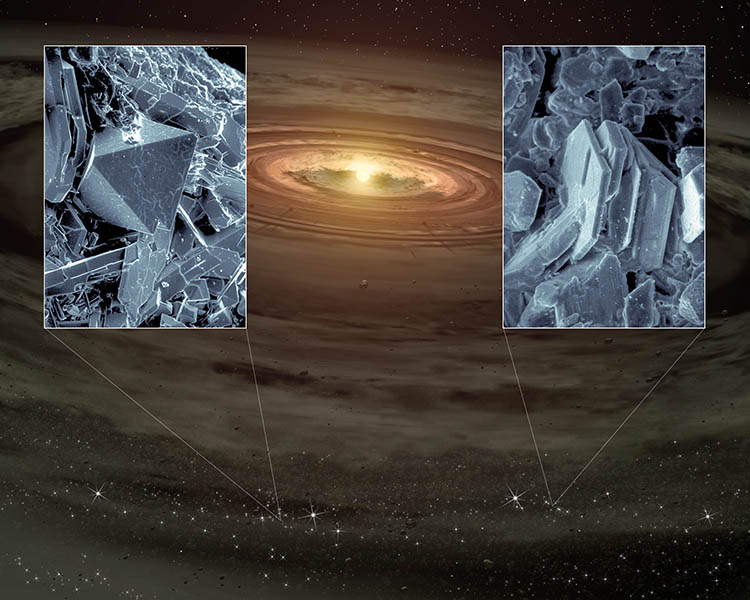[/caption]
The Spitzer Space Telescope has, for the first time, detected tiny quartz-like crystals sprinkled in young planetary systems. This surprises astronomers, because these crystals, which are types of silica minerals called cristobalite and tridymite, require flash heating events, such as shock waves, to order to form. So what is going on in these planetary disks to create this type of materials? The findings suggest that shock waves from swirling gas and dust are responsible for creating the stuff of planets throughout the universe. “Spitzer has given us a better idea of how the raw materials of planets are produced very early on,” said William Forrest of the University of Rochester, N.Y “By studying these other star systems, we can learn about the very beginnings of our own planets 4.6 billion years ago.” The big question is, though, with these crystals, can astronomers foretell the future? (Just kidding)
Planets are born out of swirling pancake-like disks of dust and gas that surround young stars. They start out as mere grains of dust swimming around in a disk of gas and dust, before lumping together to form full-fledged planets. During the early stages of planet development, the dust grains crystallize and adhere together, while the disk itself starts to settle and flatten. This occurs in the first millions of years of a star’s life.
When Forrest and his colleagues used Spitzer to examine five young planet-forming disks about 400 light-years away, they detected the signature of silica crystals. Silica is made of only silicon and oxygen and is the main ingredient in glass. When melted and crystallized, it can make the large hexagonal quartz crystals often sold as mystical tokens. When heated to even higher temperatures, it can also form small crystals like those commonly found around volcanoes.
It is this high-temperature form of silica crystals, specifically cristobalite and tridymite, that Forrest’s team found in planet-forming disks around other stars for the first time. “Cristobalite and tridymite are essentially high-temperature forms of quartz,” said Sargent. “If you heat quartz crystals, you’ll get these compounds.”
In fact, the crystals require temperatures as high as 1,220 Kelvin (about 1,740 degrees Fahrenheit) to form. But young planet-forming disks are only about 100 to 1,000 Kelvin (about minus 280 degrees Fahrenheit to 1,340 Fahrenheit) — too cold to make the crystals. Because the crystals require heating followed by rapid cooling to form, astronomers theorized that shock waves could be the cause.
Shock waves, or supersonic waves of pressure, are thought to be created in planet-forming disks when clouds of gas swirling around at high speeds collide. Some theorists think that shock waves might also accompany the formation of giant planets.
So maybe astronomers will be able to predict the type of planets in this newly forming solar system!
The findings are in agreement with local evidence from our own solar system. Spherical pebbles, called chondrules, found in ancient meteorites that fell to Earth are also thought to have been crystallized by shock waves in our solar system’s young planet-forming disk. In addition, NASA’s Stardust mission found tridymite minerals in comet Wild 2.
Forrest and University of Rochester graduate student Ben Sargent led the research, which will be published in the Astrophysical Journal.
Source: Caltech


If these young stars recently emerged from the T-tauri stage, it’s likely this material is inflow material expelled from the region very close to the star and tossed back to the outer part of the disk by off-axis bi-polar flow.
Somehow, I’m not very surprised by this discovery; heck, I would go as far to say that I thought this was discovered long ago.
I like the artwork with this article.
Could collisions of protoplanets cause enough heat to form this material?
The crystals shown are not of quartz.
u guys nerds?
The article didn’t say they actually found quartz, but quartz-LIKE crystals…more closely to silica; which actually occurs from heating up quartz!
Yes, collisions could cause enough heat to form if there is enough mass and energy or resident heat.
What is interesting is trying to figure out if this is a one, two or more stage process along with the gasseous conditions required to form that actually takes place. Also at what point are the chondrules formed… if it is part of the same process. How many collisions does it take to get to the center of a tootsie roll pop?
Very poor in heavy science, but my guess might include a heat-wave emitted when the star itself first kicked in its own heater. The star gathers materials and gravity increases, heat from this rises, eventually the nuclear heater kicks on and I would guess to a shock/heat wave going out from this first intraction. As the star settles into it’s glow and steady burning the outer rings would possibly recool rather quickly and such mineral reactions be possible??? Just my uneducated guess from bits and pieces I’ve learned.